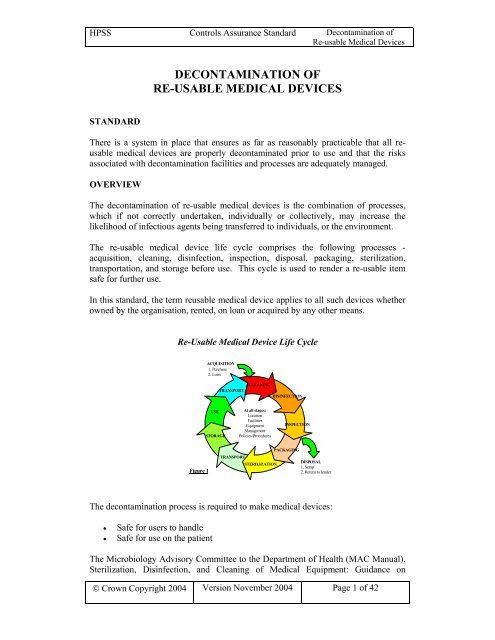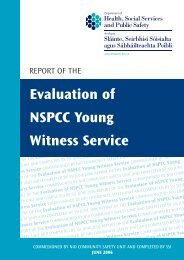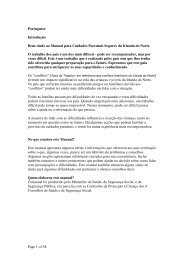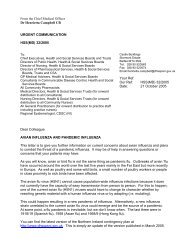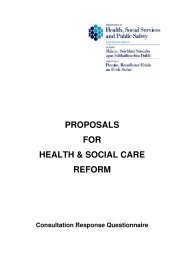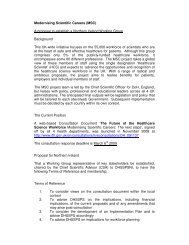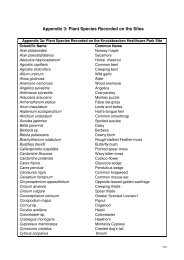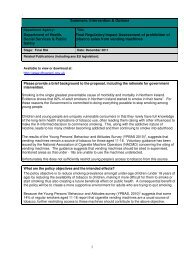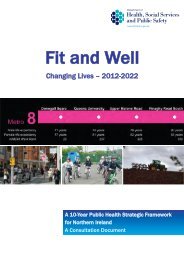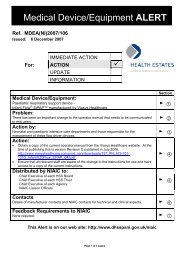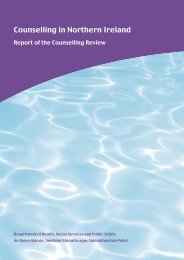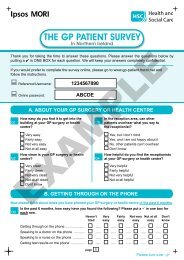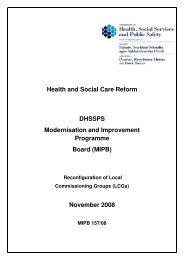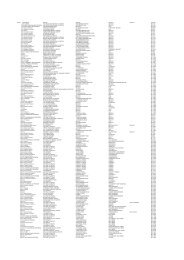Microsoft Word - Decontamination of Re-usable Medical Devices
Microsoft Word - Decontamination of Re-usable Medical Devices
Microsoft Word - Decontamination of Re-usable Medical Devices
Create successful ePaper yourself
Turn your PDF publications into a flip-book with our unique Google optimized e-Paper software.
HPSS Controls Assurance Standard <strong>Decontamination</strong> <strong>of</strong><br />
<strong>Re</strong>-<strong>usable</strong> <strong>Medical</strong> <strong>Devices</strong><br />
STANDARD<br />
DECONTAMINATION OF<br />
RE-USABLE MEDICAL DEVICES<br />
There is a system in place that ensures as far as reasonably practicable that all re<strong>usable</strong><br />
medical devices are properly decontaminated prior to use and that the risks<br />
associated with decontamination facilities and processes are adequately managed.<br />
OVERVIEW<br />
The decontamination <strong>of</strong> re-<strong>usable</strong> medical devices is the combination <strong>of</strong> processes,<br />
which if not correctly undertaken, individually or collectively, may increase the<br />
likelihood <strong>of</strong> infectious agents being transferred to individuals, or the environment.<br />
The re-<strong>usable</strong> medical device life cycle comprises the following processes -<br />
acquisition, cleaning, disinfection, inspection, disposal, packaging, sterilization,<br />
transportation, and storage before use. This cycle is used to render a re-<strong>usable</strong> item<br />
safe for further use.<br />
In this standard, the term re<strong>usable</strong> medical device applies to all such devices whether<br />
owned by the organisation, rented, on loan or acquired by any other means.<br />
<strong>Re</strong>-Usable <strong>Medical</strong> Device Life Cycle<br />
Figure 1<br />
The decontamination process is required to make medical devices:<br />
• Safe for users to handle<br />
• Safe for use on the patient<br />
ACQUISITION<br />
1. Purchase<br />
2. Loan<br />
CLEANING<br />
At all stages:<br />
Location<br />
Facilities<br />
Equipment<br />
Management<br />
Policies/Procedures<br />
DISINFECTION<br />
The Microbiology Advisory Committee to the Department <strong>of</strong> Health (MAC Manual),<br />
Sterilization, Disinfection, and Cleaning <strong>of</strong> <strong>Medical</strong> Equipment: Guidance on<br />
© Crown Copyright 2004 Version November 2004<br />
USE<br />
STORAGE<br />
TRANSPORT<br />
TRANSPORT<br />
STERILIZATION<br />
INSPECTION<br />
PACKAGING<br />
DISPOSAL<br />
1. Scrap<br />
2. <strong>Re</strong>turn to lender<br />
Page 1 <strong>of</strong> 42
HPSS Controls Assurance Standard <strong>Decontamination</strong> <strong>of</strong><br />
<strong>Re</strong>-<strong>usable</strong> <strong>Medical</strong> <strong>Devices</strong><br />
<strong>Decontamination</strong>, classifies the risk <strong>of</strong> infection associated with the decontamination<br />
<strong>of</strong> medical devices as: -<br />
High risk<br />
In close contact with a break in the skin or mucous membrane or introduced into<br />
sterile body areas.<br />
Intermediate risk<br />
In contact with mucous membranes; contaminated with particularly virulent or readily<br />
transmissible organisms; or prior to use on immunocompromised patients.<br />
Low risk<br />
In contact with healthy skin or not in contact with the patient.<br />
The key references, contained within this standard, demonstrate the wide range <strong>of</strong><br />
legislation and guidance applicable to the decontamination cycle in order to<br />
effectively achieve its objectives. These include, but are not limited to: -<br />
• The Health & Safety at Work (Northern Ireland) Order 1978 and The<br />
Management <strong>of</strong> Health and Safety at Work <strong>Re</strong>gulations (Northern Ireland)<br />
2000, which require employers to assess the risks to their employees.<br />
• Control <strong>of</strong> Substances Hazardous to Health <strong>Re</strong>gulations (Northern Ireland)<br />
2003, which provide a framework <strong>of</strong> actions designed to control the risk from<br />
a range <strong>of</strong> hazardous substances including biological agents.<br />
• EU Council Directive 93/42/EEC, concerning medical devices and the U.K.<br />
<strong>Medical</strong> <strong>Devices</strong> regulations 2002.<br />
• EU Council Directive 99/34/EEC (the Product Liability Directive), which<br />
states that a product is defective ‘if the safety <strong>of</strong> the product is not such as<br />
persons are generally entitled to expect’.<br />
The guidance given in Health Technical Memoranda (HTM), Northern Ireland<br />
Adverse Incident Centre (NIAIC) Device Bulletins, <strong>Medical</strong> Device/Equipment<br />
Alerts and DHSSPS decontamination guidance has been designed to ensure that the<br />
hazards are minimised and that decontamination procedures comply with legislative<br />
requirements and best practice.<br />
The Process Assessment Tool (PAT) issued under Addendum 2 HSS(MD)4/01 was<br />
designed to assist organisations in determining compliance with <strong>Decontamination</strong><br />
standards and guidance. The use <strong>of</strong> PAT will assist organisations to complete the<br />
Controls Assurance standards.<br />
The suggested examples <strong>of</strong> verification provided within the standard are merely<br />
auditable examples, which may be used to verify compliance with a particular<br />
criterion. Trusts may wish to use many other examples, which will vary depending on<br />
the nature <strong>of</strong> a particular organisation. These may be just as valid as the illustrative<br />
examples given in the standard. It should also be noted that any lists <strong>of</strong> examples<br />
throughout the standard are not exhaustive.<br />
If all or part <strong>of</strong> the decontamination service is provided by a third party then<br />
organisations are still required to complete the controls assurance returns against the<br />
© Crown Copyright 2004 Version November 2004 Page 2 <strong>of</strong> 42
HPSS Controls Assurance Standard <strong>Decontamination</strong> <strong>of</strong><br />
<strong>Re</strong>-<strong>usable</strong> <strong>Medical</strong> <strong>Devices</strong><br />
standard as if they are undertaking the work themselves. The assessment <strong>of</strong> the<br />
relevant criteria should be undertaken in conjunction with the third party provider.<br />
Organisations should obtain evidence to support the agreed scores for audit purposes.<br />
It is suggested that this requirement is included in the service agreement e.g. Service<br />
Level Agreement/Contract between organisations.<br />
© Crown Copyright 2004 Version November 2004<br />
Page 3 <strong>of</strong> 42
HPSS Controls Assurance Standard <strong>Decontamination</strong> <strong>of</strong><br />
<strong>Re</strong>-<strong>usable</strong> <strong>Medical</strong> <strong>Devices</strong><br />
KEY REFERENCES<br />
British Standards Institution (1989) BS 5295 - 0 Environmental cleanliness in<br />
enclosed spaces – Part 0: General introduction, terms and definitions for clean rooms<br />
and clean air devices. British Standards Institution, London<br />
British Standards Institution (1990) BS 7320 Specification for sharps containers.<br />
British Standards Institution, London<br />
British Standards Institution (1990) BS 3970 - 4 Sterilizing and disinfecting<br />
equipment for medical products: Specification for transportable steam sterilizers for<br />
unwrapped instruments. British Standards Institution, London<br />
British Standards Institution (1994) BS EN 554 Sterilization <strong>of</strong> medical devices –<br />
Validation and routine control <strong>of</strong> sterilization by moist heat. British Standards<br />
Institution, London<br />
British Standards Institution (1995) BS EN 724 Guidance on the application <strong>of</strong> BS EN<br />
29001 and BS EN 46001 and <strong>of</strong> BS EN 29002 and BS EN 46002 for non-active<br />
medical devices. British Standards Institution, London<br />
British Standards Institution (1998) BS EN 1422 Ethylene oxide sterilizers –<br />
<strong>Re</strong>quirements and test methods. British Standards Institution, London<br />
British Standards Institution (2001) BS EN ISO 13488 <strong>Medical</strong> devices – Particular<br />
requirements for the application <strong>of</strong> BS EN ISO 9002 British Standards Institution,<br />
London<br />
British Standards Institution (2001) BS EN ISO 14644 – 1 Cleanrooms and<br />
associated controlled environments – Classification <strong>of</strong> air cleanliness. British<br />
Standards Institution, London<br />
British Standards Institution (2002) BS EN 980 Graphical symbols for use in the<br />
labelling <strong>of</strong> medical devices. British Standards Institution, London<br />
Council Directive 1993/42/EEC on 14 th June 1993 concerning <strong>Medical</strong> <strong>Devices</strong>.<br />
Official Journal L169, 12/7/1993 p0001 – 0043.<br />
<strong>Medical</strong> <strong>Devices</strong> Agency <strong>Medical</strong> Device Directive 93/42/EEC <strong>Medical</strong> <strong>Devices</strong><br />
Agency, London<br />
<strong>Medical</strong> <strong>Devices</strong> <strong>Re</strong>gulations 2002. SI 2002 No 618 The stationery Office, London.<br />
Health Estates PEL(94)34 <strong>Decontamination</strong> <strong>of</strong> equipment prior to inspection, service<br />
or repair.<br />
DHSSPS Antimicrobial <strong>Re</strong>sistance Action Plan 2002 - 2005.<br />
Health and Safety at Work (Northern Ireland) Order 1978<br />
© Crown Copyright 2004 Version November 2004<br />
Page 4 <strong>of</strong> 42
HPSS Controls Assurance Standard <strong>Decontamination</strong> <strong>of</strong><br />
<strong>Re</strong>-<strong>usable</strong> <strong>Medical</strong> <strong>Devices</strong><br />
Health and Safety at Work Order (Application <strong>of</strong> Environmentally Hazardous<br />
Substances) <strong>Re</strong>gulations (Northern Ireland) 2003<br />
Management <strong>of</strong> Health and Safety at Work <strong>Re</strong>gulations (Northern Ireland) 2000 No 388<br />
Manual Handling Operations (Northern Ireland) 1992 No 535<br />
Personal Protective Equipment at Work <strong>Re</strong>gulations (Northern Ireland) 1993 SRI N0 20<br />
The Consumer Protection (Northern Ireland) Order 1987 SI No 2049 (N.I. 20)<br />
Control <strong>of</strong> Substances Hazardous to Health <strong>Re</strong>gulations (Northern Ireland) 2003<br />
Biocidal Products (Amendment) <strong>Re</strong>gulations (Northern Ireland) 2002<br />
<strong>Re</strong>porting <strong>of</strong> Injuries, Diseases and Dangerous Occurrences <strong>Re</strong>gulations (Northern<br />
Ireland) 1997 No 455<br />
The Carriage <strong>of</strong> Dangerous Goods by Road <strong>Re</strong>gulations (Northern Ireland) 1997<br />
Transport <strong>of</strong> Dangerous Goods (Safety Advisers) <strong>Re</strong>gulations (Northern Ireland)<br />
2000<br />
Carriage <strong>of</strong> Dangerous Goods (Amendment) <strong>Re</strong>gulations (Northern Ireland) 2002<br />
The Pressure Systems Safety <strong>Re</strong>gulations 2000<br />
Health Building Note (1992) (HBN) 13, Sterile Services Departments. NHS Estates,<br />
Leeds.<br />
Health Building Note (1994) (HBN) 13, Supplement 1. Ethylene Oxide Sterilization.<br />
NHS Estates, Leeds.<br />
Infection Control Nurses Association (2003) Infection Control Guidance for General<br />
Practice. ICNA: Bathgate<br />
Institute <strong>of</strong> Sterile Services Management <strong>Medical</strong> <strong>Devices</strong> Directorate (93/42/EEC)<br />
Institute <strong>of</strong> Sterile Services Management (2000) Standards and Practice. Year 2000<br />
edition. Institute <strong>of</strong> Sterile Services Management (Note- This document is currently<br />
under revision)<br />
Sterilization, Disinfection and Cleaning <strong>of</strong> <strong>Medical</strong> Equipment: Guidance on<br />
<strong>Decontamination</strong> from the Microbiology Advisory Committee to Department <strong>of</strong><br />
Health. (MAC Manual) Health Estates PEL(96)30, and Supplements 1 & 2 (available<br />
on the MHRA website at www.mhra.gov.uk )<br />
SAN (NI) 99/45 Storage <strong>of</strong> Sterile <strong>Medical</strong> <strong>Devices</strong> NIAIC<br />
© Crown Copyright 2004 Version November 2004<br />
Page 5 <strong>of</strong> 42
HPSS Controls Assurance Standard <strong>Decontamination</strong> <strong>of</strong><br />
<strong>Re</strong>-<strong>usable</strong> <strong>Medical</strong> <strong>Devices</strong><br />
SN (NI) 2003/02 Management <strong>of</strong> loaned medical equipment or accessories from<br />
manufacturers or other organisations NIAIC<br />
MDEA (NI) 2004/01 <strong>Re</strong>porting adverse incidents and disseminating <strong>Medical</strong><br />
Device/Equipment Alerts relating to medical devices, non-medical equipment,<br />
buildings and plant. NIAIC<br />
MDEA(NI)2004/34 Flexible Endoscopes: Risk <strong>of</strong> Transmission <strong>of</strong> Infection because<br />
<strong>of</strong> inadequate decontamination. NIAIC<br />
SN (NI) 2001/48 Compatibility <strong>of</strong> medical devices and reprocessing equipment with<br />
decontamination agents NIAIC<br />
SN (NI) 2001/28 Safe use and disposal <strong>of</strong> sharps NIAIC<br />
SN (NI) 2002/29 Steam penetration tests in vacuum benchtop sterilizers NIAIC<br />
DB 9901 (NI) The Validation and Periodic Testing <strong>of</strong> Benchtop Vacuum Steam<br />
Sterilizers NIAIC<br />
DB 9904 (NI) <strong>Medical</strong> Device and Equipment Management for Hospitals and<br />
Community-based Organisations NIAIC<br />
DB 9904 (NI) Supplement 1 <strong>Medical</strong> Device and Equipment Management for<br />
Hospitals and Community-based Organisations: Checks and tests for newly delivered<br />
medical devices NIAIC<br />
DB 9904 (NI) Supplement 2 <strong>Medical</strong> Device and Equipment Management for<br />
Hospitals and Community-based Organisations: Guidance on the sale, transfer <strong>of</strong><br />
ownership and disposal <strong>of</strong> used medical devices NIAIC<br />
DB 2000/02 (NI) <strong>Medical</strong> <strong>Devices</strong> and Equipment Management: <strong>Re</strong>pair and<br />
Maintenance Provision NIAIC<br />
DB 2000/04 (NI) Single use medical devices: Implications and consequences <strong>of</strong> reuse.<br />
NIAIC<br />
DB(NI) 2002/05 <strong>Decontamination</strong> <strong>of</strong> Endoscopes. NIAIC<br />
DB(NI) 2002/06 Benchtop Steam Sterilizers - Guidance on Purchase, Operation and<br />
Maintenance NIAIC<br />
NHS Estates Health (1993) Technical Memorandum HTM 2040 The control <strong>of</strong><br />
legionellae in healthcare premises - a code <strong>of</strong> practice.<br />
NHS Estates Health (1994) Technical Memorandum HTM 2025 Ventilation in<br />
healthcare premises.<br />
NHS Estates (1997) Health Technical Memorandum HTM 2031. Clean Steam for<br />
Sterilization<br />
© Crown Copyright 2004 Version November 2004 Page 6 <strong>of</strong> 42
HPSS Controls Assurance Standard <strong>Decontamination</strong> <strong>of</strong><br />
<strong>Re</strong>-<strong>usable</strong> <strong>Medical</strong> <strong>Devices</strong><br />
NHS Estates (1997) Health Technical Memorandum HTM 2010. Sterilization<br />
NHS Estates (1997) Health Technical Memorandum HTM 2030. Washer-Disinfectors<br />
NHS Estates (2002) C30 Washer/Disinfectors, A Model Engineering Specification<br />
http://www.decontamination.nhsestates.gov.uk<br />
NHS Executive (1995) NHS Internal Audit Manual 1995. NHS Executive, London.<br />
HSS (PPM) 10/2002 – Governance in the HPSS: Clinical and Social Care Governance<br />
– Guidelines on Implementation<br />
DOA (DFP) 5/2001 – Corporate Governance: Statement on Internal Control<br />
HSS (PPM) 3/2002 – Corporate Governance: Statement on Internal Control<br />
HSS(MD)4/01 <strong>Decontamination</strong> <strong>of</strong> re<strong>usable</strong> medical devices<br />
Addendum 3 HSS(MD)4/01 Protocol for local decontamination <strong>of</strong> surgical<br />
instruments<br />
HSS(MD)15/99 Variant Creutzfeldt-Jakob Disease (vCJD) : Minimising the Risk <strong>of</strong><br />
Transmission.<br />
HSS(MD)16/99 Controls Assurance in Infection Control: <strong>Decontamination</strong> <strong>of</strong><br />
<strong>Medical</strong> <strong>Devices</strong>. (and accompanying <strong>Decontamination</strong> Guidance CD-ROM)<br />
HSS(MD)36/2003 Transmissible spongiform encephalopathy agents: safe working<br />
and the prevention <strong>of</strong> infection: Publication <strong>of</strong> revised guidance<br />
HSS(SC)3/04 <strong>Decontamination</strong> <strong>of</strong> <strong>Re</strong>-<strong>usable</strong> Surgical Instruments<br />
Spongiform Encephalopathy Advisory Committee (1998) “Transmissible Spongiform<br />
Encephalopathy Agents: Safe Working and the Prevention <strong>of</strong> Infection” Advisory<br />
Committee on Dangerous Pathogens (ACDP) Spongiform Encephalopathy Advisory<br />
Committee (SEAC). The Stationery Office, London,<br />
and website http://www.doh.gov.uk/cjd/tseguidance<br />
Standards Australia (1999) Risk Management AS / NZS 4360:1999. Standards<br />
Association <strong>of</strong> Australia. Strathfield NSW.<br />
Pr<strong>of</strong>essional Estates Letter PEL(04)13, Health Estates <strong>Decontamination</strong> Testing<br />
Service, Health Estates<br />
Other <strong>Re</strong>ading<br />
Department <strong>of</strong> Health (2001) Guidance: First Principles 2001.<br />
© Crown Copyright 2004 Version November 2004<br />
Page 7 <strong>of</strong> 42
HPSS Controls Assurance Standard <strong>Decontamination</strong> <strong>of</strong><br />
<strong>Re</strong>-<strong>usable</strong> <strong>Medical</strong> <strong>Devices</strong><br />
NHS Executive (1999) Guidelines for Implementing Controls Assurance in the NHS:<br />
Guidance for Directors. NHS Executive, London<br />
Details <strong>of</strong> Department <strong>of</strong> Health and NHS Executive publications and circulars can be<br />
found at (http://www.doh.gov.uk/publications) under the COIN web site.<br />
Details <strong>of</strong> Device Bulletins (DB), Warning Notices (HN, SN etc.) are provided on the<br />
Health Estates, Northern Ireland Adverse Incident Centre (NIAIC) web site:<br />
http://www.dhsspsni.gov.uk/niaic<br />
Chief <strong>Medical</strong> Officer circulars HSS(MD)_ _ _ _ are available on the DHSSPS web<br />
site:<br />
http://www.dhsspsni.gov.uk/publichealth<br />
The HSENI web site http://www.hseni.gov.uk provides information on Northern<br />
Ireland Health and Safety legislation and codes <strong>of</strong> practice<br />
NHS Estates (2001) Infection Control in the Built Environment The Stationery Office,<br />
London<br />
http://www.nhsestates.gov.uk/download/publications_guidance/infectn.pdf<br />
NHS Executive (1995) HSG (95) 18 Hospital laundry arrangements for used and<br />
infected linen.<br />
Department <strong>of</strong> Health (1991) HC (91) 33 <strong>Decontamination</strong> <strong>of</strong> Equipment, Linen or<br />
other surfaces contaminated with Hepatitis B and/or other Human Immuno-<br />
Deficiency Viruses. Department <strong>of</strong> Health, London.<br />
NHS Executive (1995) Hospital Infection Control: Guidance on the control <strong>of</strong><br />
Infection in hospitals prepared by the joint DH/PHLS Hospital Infection Working<br />
Group HSG (95) 10 1995<br />
© Crown Copyright 2004 Version November 2004<br />
Page 8 <strong>of</strong> 42
HPSS Controls Assurance Standard <strong>Decontamination</strong> <strong>of</strong><br />
<strong>Re</strong>-<strong>usable</strong> <strong>Medical</strong> <strong>Devices</strong><br />
CRITERION 1<br />
Board level responsibility for decontamination <strong>of</strong> re-<strong>usable</strong> medical devices is<br />
clearly defined and there are clear lines <strong>of</strong> accountability for decontamination<br />
matters throughout the organisation, leading to the Board<br />
Source<br />
• HSS (PPM) 10/2002 – Governance in the HPSS: Clinical and Social Care<br />
Governance – Guidelines on Implementation<br />
• DOA (DFP) 5/2001 – Corporate Governance: Statement on Internal Control<br />
• HSS (PPM) 3/2002 – Corporate Governance: Statement on Internal Control<br />
• HSS(MD)4/01 <strong>Decontamination</strong> <strong>of</strong> re<strong>usable</strong> medical devices.<br />
• Standards Australia (1999) Risk Management AS/ NZS 4360:1999. Standards<br />
Association <strong>of</strong> Australia. Strathfield NSW.<br />
Guidance<br />
The Chief Executive is responsible for ensuring that there are effective arrangements<br />
for the decontamination <strong>of</strong> medical devices. Arrangements should include a senior<br />
member <strong>of</strong> staff with defined responsibility, (decontamination lead) who is provided<br />
with the necessary resources and authority for the task. It is expected that this <strong>of</strong>ficer<br />
will report directly to the Chief Executive.<br />
Clear lines <strong>of</strong> accountability, for all parts <strong>of</strong> the decontamination cycle should be<br />
established defining the relationships between users and the Risk Management,<br />
Clinical Governance, and Infection Control Committees and the Infection Control<br />
team.<br />
An annual report on the efficacy <strong>of</strong> the decontamination process should be submitted<br />
to the Risk Management Committee for review. This committee, which includes in<br />
its membership the Chief Executive, should present the report to the Board.<br />
The scope <strong>of</strong> responsibility should also consider contractors and pr<strong>of</strong>essional liability<br />
where the organisation either buys in or sells services to other organisations.<br />
Examples <strong>of</strong> Verification<br />
• Organisational chart indicating clear line <strong>of</strong> accountability<br />
• Job description <strong>of</strong> designated individual(s)<br />
• List <strong>of</strong> senior management contacts for out <strong>of</strong> hours support<br />
• Board and committee minutes including action and audit plans<br />
• Annual report on the application <strong>of</strong> the decontamination standards, any issues<br />
arising from non-compliance, and any progress made.<br />
• Appropriate wording in contractual agreements, which clearly specifies<br />
responsibilities, if an external supplier is used.<br />
Links with other standards<br />
All standards (generic criterion)<br />
© Crown Copyright 2004 Version November 2004<br />
Page 9 <strong>of</strong> 42
HPSS Controls Assurance Standard <strong>Decontamination</strong> <strong>of</strong><br />
<strong>Re</strong>-<strong>usable</strong> <strong>Medical</strong> <strong>Devices</strong><br />
CRITERION 2<br />
Appropriately qualified key personnel are in place in accordance with legislative<br />
and best practice guidance for decontamination.<br />
Source<br />
• Health and Safety at Work (Northern Ireland) Order 1978.<br />
• Control <strong>of</strong> Substances Hazardous to Health <strong>Re</strong>gulations (Northern Ireland) 2003<br />
• NHS Estates Health Technical Memorandum HTM 2010. Sterilization<br />
• NHS Estates Health Technical Memorandum HTM 2030. Washer-Disinfectors<br />
• HSS(MD)4/01 <strong>Decontamination</strong> <strong>of</strong> re<strong>usable</strong> medical devices<br />
Guidance<br />
Key persons and responsibilities (defined in detail in HTM 2010 and/or HTM 2030)<br />
are as follows:<br />
• The Chief Executive is ultimately accountable for the operation <strong>of</strong> the premises<br />
and the decontamination process.<br />
• The <strong>Decontamination</strong> Lead is defined as the senior member <strong>of</strong> staff with<br />
responsibility for managing all aspects <strong>of</strong> decontamination.<br />
• The User is defined as the person designated by management to be responsible for<br />
particular elements <strong>of</strong> the decontamination process. In a hospital the User could<br />
be, for example, the sterile service manager, theatre manager, endoscopy clinic<br />
manager, ward manager or laboratory manager. In primary care he /she could be a<br />
GP, practice manager, dentist or other health pr<strong>of</strong>essional.<br />
• The Competent Person (pressure vessels) is defined as a person or organisation<br />
designated by management to exercise certain legal responsibilities.<br />
• The Authorised Person (sterilizers), AP (S), is designated by management to<br />
provide independent auditing, and advice on decontamination, together with<br />
reviews and witness/validation <strong>of</strong> processes.<br />
• The Test Person (sterilizers), TP (S), is designated by management to carry out<br />
validation and periodic testing <strong>of</strong> sterilizers.<br />
• The Maintenance Person (sterilizers,) MP (S), is designated by management to<br />
carry out maintenance and periodic testing on sterilizers.<br />
• The Microbiologist (sterilizer) is designated by management to be responsible for<br />
advising the User on microbiological aspects <strong>of</strong> decontamination<br />
• The Infection Control Doctor is defined as the person designated by management<br />
to be responsible for advising the User on all aspects <strong>of</strong> infection control.<br />
Examples <strong>of</strong> Verification<br />
• Documented named individuals<br />
• Job descriptions with individuals aware <strong>of</strong> their responsibilities<br />
• Evidence <strong>of</strong> current relevant training/qualifications to fulfil the role<br />
• Support <strong>of</strong> AP (S)<br />
Links with other standards<br />
Buildings, Land and Non <strong>Medical</strong> Equipment<br />
Management <strong>of</strong> Purchasing and Supply<br />
Environmental Management<br />
Human <strong>Re</strong>sources<br />
© Crown Copyright 2004 Version November 2004<br />
Page 10 <strong>of</strong> 42
HPSS Controls Assurance Standard <strong>Decontamination</strong> <strong>of</strong><br />
<strong>Re</strong>-<strong>usable</strong> <strong>Medical</strong> <strong>Devices</strong><br />
Health and Safety<br />
Infection Control<br />
<strong>Medical</strong> <strong>Devices</strong> and Equipment Management<br />
© Crown Copyright 2004 Version November 2004<br />
Page 11 <strong>of</strong> 42
HPSS Controls Assurance Standard <strong>Decontamination</strong> <strong>of</strong><br />
<strong>Re</strong>-<strong>usable</strong> <strong>Medical</strong> <strong>Devices</strong><br />
CRITERION 3<br />
<strong>Decontamination</strong> issues are considered prior to the acquisition <strong>of</strong> re-<strong>usable</strong><br />
medical devices and decontamination equipment.<br />
Source<br />
• British Standards Institution (1994) BS EN 554 Sterilization <strong>of</strong> medical devices –<br />
Validation and routine control <strong>of</strong> sterilization by moist heat. British Standards<br />
Institution, London<br />
• DB 9904 (NI) <strong>Medical</strong> Device and Equipment Management for Hospitals and<br />
Community-based Organisations NIAIC<br />
• DB 9904 (NI) Supplement 1 <strong>Medical</strong> Device and Equipment Management for<br />
Hospitals and Community-based Organisations: Checks and tests for newly<br />
delivered medical devices<br />
• Sterilization, Disinfection and Cleaning <strong>of</strong> <strong>Medical</strong> Equipment: Guidance on<br />
<strong>Decontamination</strong> from the Microbiology Advisory Committee to Department <strong>of</strong><br />
Health. (MAC Manual) Health Estates PEL(96)30, and Supplements 1 & 2<br />
• DB 2000/02 (NI) <strong>Medical</strong> <strong>Devices</strong> and Equipment Management: <strong>Re</strong>pair and<br />
Maintenance Provision<br />
• DB(NI) 2002/06 Benchtop Steam Sterilizers - Guidance on Purchase, Operation<br />
and Maintenance<br />
• NHS Estates (1997) Health Technical Memorandum HTM 2031. Clean Steam for<br />
Sterilization<br />
• NHS Estates (1997) Health Technical Memorandum HTM 2010. Sterilization<br />
• NHS Estates Health (1997) Technical Memorandum HTM 2030. Washer-<br />
Disinfectors<br />
Guidance<br />
Organisations should have a specialist group to consider the full implications <strong>of</strong><br />
procurement and disposal <strong>of</strong> medical devices and non-medical equipment, where<br />
appropriate. Key representatives may include:<br />
• User<br />
• <strong>Medical</strong> physics<br />
• Electro-medical engineering (EME) / Electro-bio-medical engineering (EBME)<br />
• Risk management<br />
• Infection control team<br />
• Sterile services department<br />
• Estates<br />
• Procurement /purchasing<br />
• <strong>Medical</strong> and Nursing Directorate<br />
• <strong>Decontamination</strong> lead<br />
• Health and Safety<br />
• <strong>Medical</strong> Device and Equipment Committee<br />
• <strong>Medical</strong> Device and Equipment Co-ordinator<br />
The group should oversee a wide range <strong>of</strong> purchasing/acquisition issues including,<br />
where appropriate, technical specifications*. In addition, the group should ensure that<br />
the medical device manufacturer's decontamination instructions are compatible with<br />
the decontamination equipment available and policies in place. Advice on the<br />
© Crown Copyright 2004 Version November 2004<br />
Page 12 <strong>of</strong> 42
HPSS Controls Assurance Standard <strong>Decontamination</strong> <strong>of</strong><br />
<strong>Re</strong>-<strong>usable</strong> <strong>Medical</strong> <strong>Devices</strong><br />
purchase <strong>of</strong> decontamination equipment and medical devices may be sought from the<br />
Authorised Person (Sterilizers), the Sterile Services Department manager, infection<br />
control team decontamination lead, or other suitably qualified individual.<br />
Consideration should also be given to the following:<br />
• <strong>Re</strong>gulatory compliance information<br />
• Device/equipment evaluation reports<br />
• User experience and preferences<br />
• Comparing costs and features <strong>of</strong> alternative devices<br />
• Standardising on a single model where possible<br />
• Training and maintenance implications<br />
• Organisational/departmental policy<br />
• <strong>Medical</strong> Device/Equipment Alerts issued by NIAIC<br />
*A number <strong>of</strong> documents provide information on the technical requirements that<br />
should be addressed prior to purchase <strong>of</strong> specific items <strong>of</strong> equipment, for example:<br />
• HTM 2010 provides details <strong>of</strong> information to be obtained from manufacturers<br />
prior to purchasing new sterilizers. This advice includes the standards (BS or EN)<br />
to which the sterilizer should be designed and constructed and a statement <strong>of</strong><br />
compliance, installation data and engineering requirements, etc.<br />
• The MAC Manual provides generic advice on the decontamination information<br />
that users should expect to receive from manufacturers <strong>of</strong> CE marked re-<strong>usable</strong><br />
devices.<br />
• DB(NI) 2002/06 provides advice on the purchase <strong>of</strong> benchtop sterilizers<br />
• DB 9904 (NI)<br />
• A pre-purchase questionnaire may be used to assist in purchasing decisions<br />
Examples <strong>of</strong> Verification<br />
• Composition <strong>of</strong> the group/committee and terms <strong>of</strong> reference document<br />
• Group/committee minutes and action plans<br />
• Purchase considerations include a risk and impact analysis.<br />
• Cost/product life cycle details<br />
• Completion <strong>of</strong> a pre-purchase questionnaire<br />
• Policies and procedures<br />
Links with other standards<br />
Buildings, Land, Plant and Non <strong>Medical</strong> Equipment<br />
Management <strong>of</strong> Purchasing and Supply<br />
<strong>Medical</strong> <strong>Devices</strong> and Equipment Management<br />
© Crown Copyright 2004 Version November 2004<br />
Page 13 <strong>of</strong> 42
HPSS Controls Assurance Standard <strong>Decontamination</strong> <strong>of</strong><br />
<strong>Re</strong>-<strong>usable</strong> <strong>Medical</strong> <strong>Devices</strong><br />
CRITERION 4<br />
All surgical instrument sets are tracked through the decontamination process<br />
and can be traced to individual patients.<br />
Source<br />
• HSS(MD)4/01 <strong>Decontamination</strong> <strong>of</strong> re<strong>usable</strong> medical devices<br />
• SN (NI) 2003/02 Management <strong>of</strong> loaned medical equipment or accessories from<br />
manufacturers or other organisations NIAIC<br />
Guidance<br />
It is important that systems are in place to allow each surgical set <strong>of</strong> instruments to be<br />
tracked through decontamination processes in order to ensure that all aspects <strong>of</strong> the<br />
process have been carried out effectively.<br />
Examples <strong>of</strong> Verification<br />
• <strong>Re</strong>view <strong>of</strong> documentation e.g. sterilizer and washer disinfector log books, records<br />
<strong>of</strong> manual cleaning, manual/electronic tracking systems<br />
• Physical verification <strong>of</strong> decontamination processes e.g. sterilizers and washer<br />
disinfectors<br />
• Theatre records/patients notes<br />
• Policies and procedures<br />
Links with other standards<br />
Health and Safety<br />
IM&T<br />
Infection Control<br />
Management <strong>of</strong> Purchasing and Supply<br />
<strong>Medical</strong> <strong>Devices</strong> and Equipment Management<br />
<strong>Re</strong>cords Management (Standard yet to be issued)<br />
© Crown Copyright 2004 Version November 2004<br />
Page 14 <strong>of</strong> 42
HPSS Controls Assurance Standard <strong>Decontamination</strong> <strong>of</strong><br />
<strong>Re</strong>-<strong>usable</strong> <strong>Medical</strong> <strong>Devices</strong><br />
CRITERION 5<br />
All re-<strong>usable</strong> medical devices are handled, collected and delivered in a manner<br />
that reduces the risk <strong>of</strong> contamination to the product, patients, staff and any<br />
area <strong>of</strong> the healthcare facility.<br />
Source<br />
• British Standards Institution (1990) BS 7320 Specification for sharps containers.<br />
British Standards Institution, London<br />
• The Carriage <strong>of</strong> Dangerous Goods by Road <strong>Re</strong>gulations (Northern Ireland) 1997<br />
• Institute <strong>of</strong> Sterile Services Management (2000) Standards and Practice. Year<br />
2000 edition. Institute <strong>of</strong> Sterile Services Management (Note- This document is<br />
currently under revision)<br />
• Sterilization, Disinfection and Cleaning <strong>of</strong> <strong>Medical</strong> Equipment: Guidance on<br />
<strong>Decontamination</strong> from the Microbiology Advisory Committee to Department <strong>of</strong><br />
Health. (MAC Manual) Health Estates PEL(96)30, and Supplements 1 & 2<br />
Guidance<br />
The incorrect handling, collection, and delivery <strong>of</strong> medical devices may negate any<br />
decontamination process to which they have been subjected.<br />
The Institute <strong>of</strong> Sterile Service Management recommends the following:<br />
• Personnel should be trained to handle, collect and transport medical devices/<br />
equipment and, where appropriate, should wear protective clothing in accordance<br />
with local safety policies and procedures, which should include methods for<br />
dealing with spillages.<br />
• Persons aware <strong>of</strong> the potential infection hazards should separate re<strong>usable</strong> devices<br />
from clinical waste at the point <strong>of</strong> use.<br />
• <strong>Re</strong>-<strong>usable</strong> textiles should be placed in soiled linen bags and returned to the<br />
laundry service.<br />
• Contaminated medical devices should be confined and contained in closed leakpro<strong>of</strong><br />
plastic bags or containers to avoid spills, the generation <strong>of</strong> aerosols or<br />
contact with staff and environmental surfaces. They should be transported as soon<br />
as possible after use to the decontamination area; the contents <strong>of</strong> the containers<br />
should be labelled to facilitate processing.<br />
• Used equipment should be safely contained and transported to the<br />
decontamination area, and records kept <strong>of</strong> vehicles and containers used.<br />
• Contaminated medical devices and equipment must be kept separate from clean<br />
medical devices/equipment during transportation. This is achieved by using<br />
separate containers to provide physical barriers between clean and dirty items.<br />
• Contaminated medical devices / equipment shall only enter the department<br />
through the decontamination area.<br />
Examples <strong>of</strong> Verification<br />
• Documented policies and procedures<br />
• Risk Assessments<br />
• Control <strong>of</strong> Infection monitoring and audit reports<br />
• Training <strong>Re</strong>cords<br />
• Transport and Traceability <strong>Re</strong>cords<br />
• Instruction for the use <strong>of</strong> devices or equipment<br />
© Crown Copyright 2004 Version November 2004<br />
Page 15 <strong>of</strong> 42
HPSS Controls Assurance Standard <strong>Decontamination</strong> <strong>of</strong><br />
<strong>Re</strong>-<strong>usable</strong> <strong>Medical</strong> <strong>Devices</strong><br />
Links with other standards<br />
Buildings, Land and Non <strong>Medical</strong> Equipment<br />
Management <strong>of</strong> Purchasing and Supply<br />
Environmental Management<br />
Human <strong>Re</strong>sources<br />
Health and Safety<br />
Infection Control<br />
<strong>Medical</strong> <strong>Devices</strong> and Equipment Management<br />
Risk Management<br />
Fleet and Transport Management<br />
© Crown Copyright 2004 Version November 2004<br />
Page 16 <strong>of</strong> 42
HPSS Controls Assurance Standard <strong>Decontamination</strong> <strong>of</strong><br />
<strong>Re</strong>-<strong>usable</strong> <strong>Medical</strong> <strong>Devices</strong><br />
CRITERION 6<br />
<strong>Decontamination</strong>, storage and preparation <strong>of</strong> endoscopes for use is undertaken<br />
in accordance with Device Bulletin DB(NI) 2002/05 and current legislative<br />
requirements<br />
Source<br />
• HSS(MD)4/01 <strong>Decontamination</strong> <strong>of</strong> re<strong>usable</strong> medical devices<br />
• Health and Safety at Work (Northern Ireland) Order 1978<br />
• Control <strong>of</strong> Substances Hazardous to Health <strong>Re</strong>gulations (Northern Ireland) 2003<br />
• Sterilization, Disinfection and Cleaning <strong>of</strong> <strong>Medical</strong> Equipment: Guidance on<br />
<strong>Decontamination</strong> from the Microbiology Advisory Committee to Department <strong>of</strong><br />
Health. (MAC Manual) Health Estates PEL(96)30, and Supplements 1 & 2<br />
• SN (NI) 2001/48 Compatibility <strong>of</strong> medical devices and reprocessing equipment<br />
with decontamination agents NIAIC<br />
• DB(NI) 2002/05 <strong>Decontamination</strong> <strong>of</strong> Endoscopes.<br />
• HTM 2030 Washer-disinfectors<br />
• HSS(MD)15/99 Variant Creutzfeldt-Jakob Disease (vCJD) : Minimising the Risk<br />
<strong>of</strong> Transmission.<br />
• MDEA(NI)2004/34 Flexible Endoscopes: Risk <strong>of</strong> Transmission <strong>of</strong> Infection<br />
because <strong>of</strong> inadequate decontamination. NIAIC<br />
Guidance<br />
In accordance with the device manufacturer’s instructions, rigid endoscopes should be<br />
cleaned, disinfected, inspected, packaged and sterilized using validated automated<br />
processes in a Sterile Service Department wherever possible. For rigid endoscopes<br />
that cannot tolerate steam sterilization they should be cleaned and subjected to either a<br />
high-level disinfection process, using a compatible liquid chemical disinfectant, or<br />
sterilized using a suitable low temperature process.<br />
In accordance with the manufacturer’s instructions, flexible endoscopes (which<br />
cannot be autoclaved) should be cleaned and subjected to high-level disinfection<br />
using a suitable and compatible liquid chemical disinfectant in an automated<br />
endoscope reprocessor (AER).<br />
Where practical, single use accessories should be used and should never be reused.<br />
<strong>Re</strong><strong>usable</strong> endoscopic accessories should be reprocessed in a Sterile Service<br />
Department using a validated automated process in accordance with the device<br />
manufacturer’s instructions.<br />
Flexible endoscopes and accessories should be traceable in accordance with the<br />
requirements <strong>of</strong> HSS(MD)15/99.<br />
Rigid endoscopes must be stored sealed in the container or packaging in which they<br />
were sterilized. Flexible endoscopes should be dried and stored suspended vertically<br />
in ventilated storage cabinets, to allow circulation <strong>of</strong> air. They should not be in<br />
contact with other endoscopes or flat surfaces, and should be re-processed prior to<br />
use.<br />
© Crown Copyright 2004 Version November 2004<br />
Page 17 <strong>of</strong> 42
HPSS Controls Assurance Standard <strong>Decontamination</strong> <strong>of</strong><br />
<strong>Re</strong>-<strong>usable</strong> <strong>Medical</strong> <strong>Devices</strong><br />
The use <strong>of</strong> liquid chemical disinfectants and sterilization agents is covered by the<br />
Control <strong>of</strong> Substances Hazardous to Health <strong>Re</strong>gulations (COSHH). The Health and<br />
Safety Executive has set a Maximum Exposure Limit <strong>of</strong> 0.05ppm for glutaraldehyde.<br />
Failure to comply with COSHH regulations constitutes an <strong>of</strong>fence and renders the<br />
employer liable under the Health and Safety at Work (Northern Ireland) Order 1978<br />
Examples <strong>of</strong> Verification<br />
Documented policies and procedures for the cleaning, disinfection and sterilization <strong>of</strong><br />
endoscopes and re-<strong>usable</strong> accessories, which may include the following: -<br />
• Disinfectant, concentration, contact time, maximum number <strong>of</strong> uses, shelf life or<br />
made-up disinfectant and method <strong>of</strong> safe disposal<br />
• Type <strong>of</strong> disinfectant utilised<br />
• Evidence <strong>of</strong> Risk assessment undertaken to meet COSHH requirements<br />
• Physical verification <strong>of</strong> facilities<br />
• Personal protective equipment available<br />
• Atmospheric monitoring<br />
• Health surveillance<br />
• Training programmes<br />
• Control measures and spillage procedures<br />
Links with other standards<br />
<strong>Medical</strong> <strong>Devices</strong> and Equipment Management<br />
Buildings, Land, Plant and Non-medical Equipment<br />
Management <strong>of</strong> Purchasing and Supply<br />
Environmental Management<br />
Human <strong>Re</strong>sources<br />
Health and Safety<br />
Infection Control<br />
<strong>Re</strong>cords Management<br />
Risk Management<br />
© Crown Copyright 2004 Version November 2004<br />
Page 18 <strong>of</strong> 42
HPSS Controls Assurance Standard <strong>Decontamination</strong> <strong>of</strong><br />
<strong>Re</strong>-<strong>usable</strong> <strong>Medical</strong> <strong>Devices</strong><br />
CRITERION 7<br />
All other re-<strong>usable</strong> medical devices are decontaminated and stored in accordance<br />
with legislative and best practice requirements<br />
Source<br />
• Health Building Note (HBN) 13, Supplement 1. Ethylene Oxide Sterilization<br />
• Institute <strong>of</strong> Sterile Services Management (2000) Standards and Practice. Year<br />
2000 edition. Institute <strong>of</strong> Sterile Services Management (Note- This document is<br />
currently under revision)<br />
• Sterilization, Disinfection and Cleaning <strong>of</strong> <strong>Medical</strong> Equipment: Guidance on<br />
<strong>Decontamination</strong> from the Microbiology Advisory Committee to Department <strong>of</strong><br />
Health. (MAC Manual) Health Estates PEL(96)30, and Supplements 1 & 2<br />
• SAN (NI) 99/45 Storage <strong>of</strong> Sterile <strong>Medical</strong> <strong>Devices</strong> NIAIC<br />
• DB(NI) 2002/06 Benchtop Steam Sterilizers - Guidance on Purchase, Operation<br />
and Maintenance<br />
• DB 9901 (NI) The Validation and Periodic Testing <strong>of</strong> Benchtop Vacuum Steam<br />
Sterilizers<br />
• DB 2000/04 (NI) Single use medical devices: Implications and consequences <strong>of</strong><br />
reuse.<br />
• Addendum 3 HSS(MD)4/01 Protocol for local decontamination <strong>of</strong> surgical<br />
instruments<br />
• NHS Estates (2002) C30 Washer/Disinfectors, A Model Engineering Specification<br />
• NHS Estates Health Technical Memorandum HTM 2031. Clean Steam for<br />
Sterilization<br />
• NHS Estates Health Technical Memorandum HTM 2010. Sterilization<br />
• NHS Estates Health Technical Memorandum HTM 2030. Washer-Disinfectors<br />
• HSS(MD)16/99 Controls Assurance in Infection Control: <strong>Decontamination</strong> <strong>of</strong><br />
<strong>Medical</strong> <strong>Devices</strong>.<br />
• HSS(MD)15/99 Variant Creutzfeldt-Jakob Disease (vCJD) : Minimising the Risk<br />
<strong>of</strong> Transmission.<br />
Guidance<br />
Wherever possible, the decontamination <strong>of</strong> re-<strong>usable</strong> medical devices should be<br />
carried out in the sterile services department. <strong>Decontamination</strong> is the combination <strong>of</strong><br />
processes, including cleaning, disinfection and/or sterilization, used to render a re<strong>usable</strong><br />
medical device safe for further episodes <strong>of</strong> use. In order to decontaminate<br />
medical devices effectively, all organic debris (e.g. blood, tissue and other body<br />
fluids) must be removed from the item prior to disinfection and/or sterilization.<br />
Effective cleaning <strong>of</strong> medical devices prior to disinfection or sterilization is <strong>of</strong> the<br />
utmost importance in reducing the risk <strong>of</strong> transmission <strong>of</strong> infectious agents. <strong>Medical</strong><br />
devices intended for single-use only should not be re-processed for re-use.<br />
Policies should exist as a point <strong>of</strong> reference, and should be available for all personnel<br />
involved in any aspect <strong>of</strong> decontamination.<br />
• All stages <strong>of</strong> the decontamination process should be clearly defined, documented<br />
and controlled<br />
• There should be a regular review <strong>of</strong> all procedures and any changes documented<br />
• Processing data should be retained<br />
© Crown Copyright 2004 Version November 2004 Page 19 <strong>of</strong> 42
HPSS Controls Assurance Standard <strong>Decontamination</strong> <strong>of</strong><br />
<strong>Re</strong>-<strong>usable</strong> <strong>Medical</strong> <strong>Devices</strong><br />
<strong>Devices</strong> should be cleaned in accordance with manufacturer instructions. Cleaning<br />
can be separated into mechanical processes, using an automated washer-disinfector or<br />
ultrasonic and manual processes.<br />
Automated mechanical cleaning provides an efficient, reproducible process whose<br />
effectiveness can be validated. This is the preferred method <strong>of</strong> cleaning, as it is more<br />
consistent and easily controlled than manual methods.<br />
Automated washer-disinfectors<br />
• Mechanical washer-disinfectors should be specified, in accordance with BS 2745<br />
and NHS Estates C30 and monitored in accordance with HTM 2030, “Washerdisinfectors”.<br />
• Endotoxin levels in rinse water should be included in the process control and<br />
monitoring procedures.<br />
Manual cleaning<br />
• Manual cleaning should be carried out in accordance with Addendum 3<br />
HSS(MD)4/01 “Protocol for local decontamination <strong>of</strong> surgical instruments”.<br />
Unless the item to be sterilized is known to be damaged by the application <strong>of</strong> heat or<br />
moisture, then moist heat sterilization using steam under pressure should always be<br />
used in preference to other methods since it is more reliable and can be monitored<br />
effectively.<br />
Sterilizers<br />
Particular attention should be paid to the following areas:<br />
• Validation and management <strong>of</strong> sterilization equipment using HTM 2010<br />
• Monitoring <strong>of</strong> the steam supply <strong>of</strong> porous load sterilizers using HTM 2031<br />
• Ensuring ethylene oxide sterilizer installations meet HBN 13 Supplement 1<br />
Benchtop Steam Sterilizers<br />
DB(NI) 2002/06 and HTM 2010 provide detailed guidance on the use and testing <strong>of</strong><br />
benchtop sterilizers. In particular, organisations should ensure that the following are<br />
not sterilized using a traditional benchtop sterilizer:<br />
• Single use devices<br />
• <strong>Devices</strong> in any form <strong>of</strong> wrapping (including pouches)<br />
• Equipment with lumens or cavities<br />
• Porous loads<br />
Benchtop steam sterilizers should be fitted with independent process monitoring or<br />
recording equipment and frequent periodic reviews <strong>of</strong> their effectiveness against<br />
relevant guidance should be undertaken.<br />
Benchtop sterilizers are primarily intended to be used to sterilize loads for immediate<br />
use.<br />
Benchtop Vacuum Steam Sterilizers<br />
© Crown Copyright 2004 Version November 2004<br />
Page 20 <strong>of</strong> 42
HPSS Controls Assurance Standard <strong>Decontamination</strong> <strong>of</strong><br />
<strong>Re</strong>-<strong>usable</strong> <strong>Medical</strong> <strong>Devices</strong><br />
• DB 9901 (NI), DB(NI) 2002/06 provide detailed guidance on the use and testing<br />
<strong>of</strong> vacuum benchtop steam sterilizers. The use <strong>of</strong> hot air ovens is not<br />
recommended for the routine sterilization <strong>of</strong> surgical instruments.<br />
Sterile products should be stored in a clean, cool and dry environment, away from the<br />
floor and walls and out <strong>of</strong> direct sunlight.<br />
Examples <strong>of</strong> Verification<br />
• Physical verification that single use devices are not being re-used<br />
• Policy defining all stages <strong>of</strong> the decontamination process, that is readily available<br />
to staff<br />
• Audit <strong>of</strong> policies and procedures<br />
• Documented evidence <strong>of</strong> testing, monitoring and maintenance<br />
• Annual pressure vessel tests<br />
• Certificate <strong>of</strong> registration <strong>of</strong> sterile services department under <strong>Medical</strong> <strong>Devices</strong><br />
Directive 93/42/EEC (verifies compliance <strong>of</strong> sterile services department only)<br />
• Physical verification <strong>of</strong> adequate storage facilities and environmental control.<br />
Links with other standards<br />
Buildings, Land, Plant and Non-medical Equipment<br />
Health and Safety<br />
Infection Control<br />
Management <strong>of</strong> Purchasing and Supply<br />
<strong>Medical</strong> <strong>Devices</strong> and Equipment Management<br />
Pr<strong>of</strong>essional and Product Liability<br />
© Crown Copyright 2004 Version November 2004<br />
Page 21 <strong>of</strong> 42
HPSS Controls Assurance Standard <strong>Decontamination</strong> <strong>of</strong><br />
<strong>Re</strong>-<strong>usable</strong> <strong>Medical</strong> <strong>Devices</strong><br />
CRITERION 8<br />
<strong>Decontamination</strong> equipment is subject to validation, calibration, monitoring and<br />
maintenance by appropriately qualified persons.<br />
Source<br />
• British Standards Institution (1990) BS 3970 - 4 Sterilizing and disinfecting<br />
equipment for medical products: Specification for transportable steam sterilizers<br />
for unwrapped instruments. British Standards Institution, London<br />
• European Standard EN 1422 Ethylene Oxide Sterilizers (Specifications)<br />
• Health Building Note (HBN) 13, Supplement 1. Ethylene Oxide Sterilization<br />
• DB 9901 (NI) The Validation and Periodic Testing <strong>of</strong> Benchtop Vacuum Steam<br />
Sterilizers<br />
• DB(NI) 2002/06 Benchtop Steam Sterilizers - Guidance on Purchase, Operation<br />
and Maintenance<br />
• NHS Estates Health Technical Memorandum HTM 2031. Clean Steam for<br />
Sterilization<br />
• NHS Estates Health Technical Memorandum HTM 2010. Sterilization<br />
• NHS Estates Health Technical Memorandum HTM 2030. Washer-Disinfectors<br />
• Pr<strong>of</strong>essional Estates Letter PEL(04)13, Health Estates <strong>Decontamination</strong> Testing<br />
Service, Health Estates<br />
Guidance<br />
Planned maintenance is an essential part <strong>of</strong> the decontamination process. Equipment<br />
(washer-disinfectors, sterilizers etc.) to be used in validated processes requires<br />
planned preventative maintenance and periodic calibration and testing to ensure it<br />
remains in the same condition as when validated. Validated processes require<br />
monitoring <strong>of</strong> critical variables <strong>of</strong> each cycle and this should be independent <strong>of</strong> any<br />
monitoring used to control the decontamination equipment. Processes that require<br />
validation should only be carried out using automated equipment to ensure<br />
reproducibility.<br />
Failure to maintain the equipment and its systems gives rise to the potential for<br />
inadequate decontamination.<br />
HTM 2010, HTM 2030, DB 9901 (NI) and DB(NI) 2002/06 define the minimum<br />
standards required to ensure safe operation <strong>of</strong> the decontamination process.<br />
The key areas are:<br />
Washer-disinfectors (including automatic endoscope reprocessors)<br />
The control protocols described in HTM 2030 provide the means for ensuring that a<br />
washer-disinfector is fit for its intended purpose and is subject to a planned<br />
programme <strong>of</strong>:<br />
• Tests ensuring that standards <strong>of</strong> performance and safety are met<br />
• Tests to monitor performance<br />
• Preventative maintenance<br />
© Crown Copyright 2004 Version November 2004<br />
Page 22 <strong>of</strong> 42
HPSS Controls Assurance Standard <strong>Decontamination</strong> <strong>of</strong><br />
<strong>Re</strong>-<strong>usable</strong> <strong>Medical</strong> <strong>Devices</strong><br />
The protocols also ensure that the equipment is operated in accordance with an agreed<br />
procedure by staff trained in its use and that the User is designated to exercise certain<br />
responsibilities <strong>of</strong> inspection.<br />
The washer-disinfector should be validated in accordance with the guidance in<br />
HTM2030 and it is strongly recommended that in all cases the User receive<br />
pr<strong>of</strong>essional advice from a microbiologist and/or an AP (S).<br />
Benchtop Sterilizers<br />
DB 9901 (NI), DB(NI) 2002/06 and HTM 2010 provide testing and maintenance<br />
requirements for benchtop sterilizers. In particular:<br />
• The User is responsible for ensuring that daily, quarterly and annual testing is<br />
carried out.<br />
• Weekly tests and safety checks should be undertaken<br />
• Planned maintenance should be carried out as per the sterilizer manufacturer's<br />
instructions and HTM 2010<br />
• The records <strong>of</strong> the above tests should be kept in a logbook (see DB(NI) 2002/06).<br />
Ethylene Oxide Sterilization<br />
Where ethylene oxide sterilization is employed, the following is required, as defined<br />
in HBN 13 supplement 1.<br />
• The sterilizer should be specified, installed, commissioned and processes<br />
validated following the guidance in HTM 2010 or other recognised sterilization<br />
standards.<br />
• The use <strong>of</strong> a microbiological system for routine monitoring <strong>of</strong> the process<br />
• Since ethylene oxide is toxic and leaves residues, the aeration and degassing<br />
during quarantine <strong>of</strong> the product must be included as part <strong>of</strong> the validation process<br />
The guidance in HTM 2010 should also be followed.<br />
The Pressure Systems Safety <strong>Re</strong>gulations 2000, which are a statutory requirement,<br />
apply to any vessel that contains steam at any pressure. It applies to most, if not all,<br />
benchtop steam sterilizers and to other equipment in which steam is generated e.g.<br />
some washer-disinfectors. These regulations require a Competent Person (Pressure<br />
Vessels) who is not the User (see criterion 13), to be designated to exercise certain<br />
responsibilities. These include verifying the suitability <strong>of</strong> the written scheme <strong>of</strong><br />
examination and performing the examination in accordance with the written scheme.<br />
Examples <strong>of</strong> Verification<br />
• Schedules and documentation for installation checks, validation tests and periodic<br />
tests by AP (Sterilizers)<br />
• Plant history file and a sterilizer process log<br />
• Log <strong>of</strong> daily and weekly testing for benchtop sterilizers<br />
• Testing and maintenance is carried out by individuals with the appropriate skills /<br />
training (see HTM 2010 or HTM 2030)<br />
• Protocol for test failures<br />
• ICT monitoring and reports given to ICC<br />
Links with other standards<br />
Buildings, Land and Non <strong>Medical</strong> Equipment<br />
© Crown Copyright 2004 Version November 2004<br />
Page 23 <strong>of</strong> 42
HPSS Controls Assurance Standard <strong>Decontamination</strong> <strong>of</strong><br />
<strong>Re</strong>-<strong>usable</strong> <strong>Medical</strong> <strong>Devices</strong><br />
Management <strong>of</strong> Purchasing and supply<br />
Human <strong>Re</strong>sources<br />
Health and Safety<br />
Infection Control<br />
<strong>Medical</strong> <strong>Devices</strong> and Equipment Management<br />
Pr<strong>of</strong>essional and Product Liability<br />
<strong>Re</strong>cords Management<br />
© Crown Copyright 2004 Version November 2004<br />
Page 24 <strong>of</strong> 42
HPSS Controls Assurance Standard <strong>Decontamination</strong> <strong>of</strong><br />
<strong>Re</strong>-<strong>usable</strong> <strong>Medical</strong> <strong>Devices</strong><br />
CRITERION 9<br />
Ethylene oxide sterilizers are operated and used in accordance with legislative<br />
and best practice requirements.<br />
Source<br />
• Control <strong>of</strong> Substances Hazardous to Health <strong>Re</strong>gulations (Northern Ireland) 2003<br />
• Health Building Note (HBN) 13, Supplement 1. Ethylene Oxide Sterilization<br />
Guidance<br />
Ethylene oxide is hazardous. It is toxic, flammable and a wide range <strong>of</strong> mixtures with<br />
air are explosive. It is also classified as a human carcinogen and therefore needs to<br />
be handled safely, with necessary precautions taken.<br />
HBN 13, supplement 1 provides details <strong>of</strong> the requirements for the installation <strong>of</strong><br />
ethylene oxide sterilizers. This includes, but is not limited to, a number <strong>of</strong> operational<br />
safety requirements defined in paragraph 2.5, which should be present as well as fire<br />
precautions stated in paragraph 3.5.<br />
The operational safety requirements specific to positive pressure sterilizers is also<br />
described in HBN13 Supplement 1.<br />
Schedule 1 <strong>of</strong> the Control <strong>of</strong> Substances Hazardous to Health (COSHH) <strong>Re</strong>gulations<br />
lists ethylene oxide as a substance, which is subject to maximum exposure limit for<br />
inhalation. These limits are reviewed annually and up-dated by amendments. These<br />
limits must be regarded as safe work exposures.<br />
Where products are sterilized by ethylene oxide using a third party, evidence <strong>of</strong><br />
compliance and validation with this criterion should be sought.<br />
Examples <strong>of</strong> Verification<br />
• Operational procedures<br />
• Prominent display <strong>of</strong> procedures for detailed processes<br />
• List <strong>of</strong> authorised operators and safeguards to prevent unauthorised access<br />
• Physical verification <strong>of</strong> environment<br />
• Availability <strong>of</strong> goggles and respirators for use in an emergency or maintenance<br />
• Physical verification against requirements in HBN 13, supplement 1<br />
• Environmental sampling and COSHH test results<br />
Links with other standards<br />
Health and Safety<br />
Risk Management<br />
© Crown Copyright 2004 Version November 2004<br />
Page 25 <strong>of</strong> 42
HPSS Controls Assurance Standard <strong>Decontamination</strong> <strong>of</strong><br />
<strong>Re</strong>-<strong>usable</strong> <strong>Medical</strong> <strong>Devices</strong><br />
CRITERION 10<br />
All medical devices, decontamination equipment and surfaces are appropriately<br />
dealt with after use on patients known to have or who are in a risk category for<br />
CJD.<br />
Source<br />
• HSS(MD)15/99 Variant Creutzfeldt-Jakob Disease (vCJD) : Minimising the Risk<br />
<strong>of</strong> Transmission.<br />
• HSS(MD)16/99 Controls Assurance in Infection Control: <strong>Decontamination</strong> <strong>of</strong><br />
<strong>Medical</strong> <strong>Devices</strong>.<br />
• Spongiform Encephalopathy Advisory Committee (1998) “Transmissible<br />
Spongiform Encephalopathy Agents: Safe Working and the Prevention <strong>of</strong><br />
Infection” (Advisory Committee on Dangerous Pathogens (ACDP) Spongiform<br />
Encephalopathy Advisory Committee (SEAC)<br />
• HSS(MD)36/2003 Transmissible spongiform encephalopathy agents: safe<br />
working and the prevention <strong>of</strong> infection: Publication <strong>of</strong> revised guidance<br />
Guidance<br />
“Transmissible Spongiform Encephalopathy Agents. Safe Working and the<br />
Prevention <strong>of</strong> Infection” provides guidance to employers on the precautions necessary<br />
to minimise the exposure <strong>of</strong> employees and others to TSE agents from work activities.<br />
HSS(MD)15/99 and HSS(MD)36/2003 outline the ACDP/SEAC guidance and state ‘<br />
it is essential that all existing cleaning and sterilization procedures operate to the<br />
highest standards’.<br />
Detailed guidance can be found on all other aspects within the document<br />
"Transmissible Spongiform Encephalopathy Agents. Safe Working and the<br />
Prevention <strong>of</strong> Infection" which is available from<br />
http://www.doh.gov.uk/cjd/tseguidance<br />
Examples <strong>of</strong> Verification<br />
• Documented procedures<br />
• Local guidance which reflects national TSE requirements<br />
• COSHH assessments<br />
• Training logs.<br />
• Availability and staff awareness <strong>of</strong> source documents<br />
Links with other standards<br />
Health and Safety<br />
Infection Control<br />
Human <strong>Re</strong>sources<br />
Risk Management<br />
© Crown Copyright 2004 Version November 2004<br />
Page 26 <strong>of</strong> 42
HPSS Controls Assurance Standard <strong>Decontamination</strong> <strong>of</strong><br />
<strong>Re</strong>-<strong>usable</strong> <strong>Medical</strong> <strong>Devices</strong><br />
CRITERION 11<br />
All decontamination equipment that does not meet the requirements <strong>of</strong> current<br />
standards and test methods is upgraded or replaced as soon as practicable in<br />
accordance with a planned replacement programme.<br />
Source<br />
• HSS(MD)16/99 Controls Assurance in Infection Control: <strong>Decontamination</strong> <strong>of</strong><br />
<strong>Medical</strong> <strong>Devices</strong><br />
• HSS(SC)3/04 <strong>Decontamination</strong> <strong>of</strong> <strong>Re</strong>-<strong>usable</strong> Surgical Instruments<br />
• DB 9904 (NI) <strong>Medical</strong> Device and Equipment Management for Hospitals and<br />
Community-based Organisations NIAIC<br />
• MDEA(NI)2004/34 Flexible Endoscopes: Risk <strong>of</strong> Transmission <strong>of</strong> Infection<br />
because <strong>of</strong> inadequate decontamination. NIAIC<br />
Guidance<br />
HPSS organisations should develop a programme to upgrade or replace as soon as<br />
practicable any decontamination equipment that does not meet the requirements <strong>of</strong><br />
current standards.<br />
A continuous review process should be in place in order to determine the best value<br />
for money means <strong>of</strong> providing the service. Consideration <strong>of</strong> centralised or<br />
decentralised services should be part <strong>of</strong> this review.<br />
Examples <strong>of</strong> Verification<br />
• Risk assessment <strong>of</strong> decontamination processing<br />
• Action plan to mitigate identified risks<br />
• Risk treatment plans to mitigate any residual risks<br />
• ICT monitoring, audit and action reports<br />
• <strong>Decontamination</strong> equipment validation results<br />
• Organisation’s Development and Operational Strategy<br />
• Estates Strategy<br />
• Documented planned replacement programme<br />
Links with other standards<br />
Buildings, Land and Non <strong>Medical</strong> Equipment<br />
Management <strong>of</strong> Purchasing and Supply<br />
Infection Control<br />
<strong>Medical</strong> <strong>Devices</strong> and Equipment Management<br />
<strong>Re</strong>cords Management<br />
© Crown Copyright 2004 Version November 2004<br />
Page 27 <strong>of</strong> 42
HPSS Controls Assurance Standard <strong>Decontamination</strong> <strong>of</strong><br />
<strong>Re</strong>-<strong>usable</strong> <strong>Medical</strong> <strong>Devices</strong><br />
CRITERION 12<br />
All medical devices that cannot be easily cleaned and/or those in poor condition,<br />
are identified and subject to a planned replacement programme with equipment<br />
that is easier to clean, or replaced by a single use alternative.<br />
Source<br />
• DB 9904 (NI) <strong>Medical</strong> Device and Equipment Management for Hospitals and<br />
Community-based Organisations NIAIC<br />
• Sterilization, Disinfection and Cleaning <strong>of</strong> <strong>Medical</strong> Equipment: Guidance on<br />
<strong>Decontamination</strong> from the Microbiology Advisory Committee to Department <strong>of</strong><br />
Health. (MAC Manual) Health Estates PEL(96)30, and Supplements 1 & 2<br />
• HSS(MD)16/99 Controls Assurance in Infection Control: <strong>Decontamination</strong> <strong>of</strong><br />
<strong>Medical</strong> <strong>Devices</strong><br />
• Health Estates PEL(94)34 <strong>Decontamination</strong> <strong>of</strong> Equipment prior to Inspection,<br />
Service and <strong>Re</strong>pair<br />
• MDEA(NI)2004/34 Flexible Endoscopes: Risk <strong>of</strong> Transmission <strong>of</strong> Infection<br />
because <strong>of</strong> inadequate decontamination. NIAIC<br />
Guidance<br />
<strong>Decontamination</strong> processes are less effective on instruments that are difficult to clean<br />
and/or in poor condition.<br />
For certain complex medical devices, it may be necessary to disassemble the device<br />
prior to decontamination. The manufacturer’s instructions should be followed and all<br />
the surfaces exposed to the cleaning processes. It is also important that medical<br />
devices are correctly loaded into the automated washer-disinfectors so that the<br />
maximum cleaning efficacy can be achieved.<br />
Automated mechanical cleaning provides an efficient, reproducible process whose<br />
effectiveness can be verified. It is more consistent and more easily controlled, than<br />
manual methods.<br />
Therefore, consideration should be given to purchasing medical devices that can be<br />
mechanically cleaned or replaced by a single use alternative.<br />
Examples <strong>of</strong> Verification<br />
• Risk assessment <strong>of</strong> instrument decontamination processing<br />
• Action plan to mitigate identified risks<br />
• Risk treatment plans to mitigate any residual risks<br />
• ICT monitoring, audit and action reports<br />
• <strong>Decontamination</strong> validation results<br />
• Organisation’s Operational Strategy<br />
• Documented planned replacement programme<br />
• Instrument inventories<br />
• Manufacturers cleaning instructions<br />
Links with other standards<br />
Management <strong>of</strong> Purchasing and Supply<br />
Infection Control<br />
© Crown Copyright 2004 Version November 2004<br />
Page 28 <strong>of</strong> 42
HPSS Controls Assurance Standard <strong>Decontamination</strong> <strong>of</strong><br />
<strong>Re</strong>-<strong>usable</strong> <strong>Medical</strong> <strong>Devices</strong><br />
<strong>Medical</strong> <strong>Devices</strong> and Equipment Management<br />
<strong>Re</strong>cords Management<br />
Risk Management<br />
© Crown Copyright 2004 Version November 2004<br />
Page 29 <strong>of</strong> 42
HPSS Controls Assurance Standard <strong>Decontamination</strong> <strong>of</strong><br />
<strong>Re</strong>-<strong>usable</strong> <strong>Medical</strong> <strong>Devices</strong><br />
CRITERION 13<br />
Sterile Services Department facilities meet the standards and requirements for<br />
the segregation <strong>of</strong> controlled environments.<br />
Source<br />
• British Standards Institution (1989) BS 5295 - 0 Environmental cleanliness in<br />
enclosed spaces – Part 0: General introduction, terms and definitions for clean<br />
rooms and clean air devices. British Standards Institution, London<br />
• British Standards Institution (1995) BS EN 724 Guidance on the application <strong>of</strong> BS<br />
EN 29001 and BS EN 46001 and <strong>of</strong> BS EN 29002 and BS EN 46002 for nonactive<br />
medical devices. British Standards Institution, London<br />
• British Standards Institution (2001) BS EN ISO 14644 – 1 Cleanrooms and<br />
associated controlled environments – Classification <strong>of</strong> air cleanliness. British<br />
Standards Institution, London<br />
• Health Building Note (HBN) 13, Sterile Services Department<br />
• Institute <strong>of</strong> Sterile Services Management (2000) Standards and Practice. Year<br />
2000 edition. Institute <strong>of</strong> Sterile Services Management (Note- This document is<br />
currently under revision)<br />
Guidance<br />
To achieve the required standard there must be segregation <strong>of</strong> soiled returns and clean<br />
supply (see HBN 13 for advice).<br />
There will be separate areas for the following:<br />
• <strong>Re</strong>ception, sorting and decontamination <strong>of</strong> re<strong>usable</strong> medical devices and<br />
equipment<br />
• Inspection and function testing <strong>of</strong> decontaminated devices / equipment<br />
• Preparation and assembly <strong>of</strong> packs<br />
• Pre-sterilization holding areas<br />
• Sterilization<br />
• Processed goods storage<br />
• Distribution <strong>of</strong> processed items<br />
• Raw materials preparation and storage<br />
• Administration and training<br />
• Staff changing and rest areas<br />
All personnel entering and leaving the cleanroom must do so through a dedicated<br />
entrance / exit and wear appropriate clothing whilst in the area.<br />
All persons requiring entry to the clean production area should:<br />
• Enter through the dedicated gowning area<br />
• Wear head cover and dedicated footwear<br />
• Thoroughly wash and dry hands and don a clean, non-linting gown<br />
• Exit through the gowning area where clean room clothing will be removed and<br />
discarded into an appropriate facility. The use <strong>of</strong> clean - room clothing outside <strong>of</strong><br />
the clean area contributes to the risk <strong>of</strong> contamination and should be prohibited.<br />
HBN 13 refers to the design <strong>of</strong> new SSD facilities. Its standards should be compared<br />
with those in existing departments as part <strong>of</strong> the risk assessment and management<br />
© Crown Copyright 2004 Version November 2004 Page 30 <strong>of</strong> 42
HPSS Controls Assurance Standard <strong>Decontamination</strong> <strong>of</strong><br />
<strong>Re</strong>-<strong>usable</strong> <strong>Medical</strong> <strong>Devices</strong><br />
process. Adoption <strong>of</strong> the design standards as a principle is encouraged, and action<br />
plans to bring existing facilities up to this standard should form part <strong>of</strong> the<br />
organisation’s risk treatment plan.<br />
Examples <strong>of</strong> Verification<br />
• Physical verification <strong>of</strong> workflows<br />
• Documented procedures for control <strong>of</strong> personnel in all controlled environments<br />
• Risk assessment <strong>of</strong> existing facilities detailing areas at risk from lack <strong>of</strong><br />
segregation.<br />
• Action plan to mitigate identified risks<br />
• Risk treatment plans to mitigate any residual risks<br />
• ICT monitoring, audit and action reports<br />
Links with other standards<br />
Buildings, Land, Plant and Non-medical Equipment<br />
Management <strong>of</strong> Purchasing and Supply<br />
Health and Safety<br />
Infection Control<br />
<strong>Re</strong>cords Management<br />
Risk Management<br />
Waste Management<br />
© Crown Copyright 2004 Version November 2004<br />
Page 31 <strong>of</strong> 42
HPSS Controls Assurance Standard <strong>Decontamination</strong> <strong>of</strong><br />
<strong>Re</strong>-<strong>usable</strong> <strong>Medical</strong> <strong>Devices</strong><br />
CRITERION 14<br />
All other locations in which the decontamination <strong>of</strong> re-<strong>usable</strong> medical devices is<br />
carried out are dedicated for the purpose and appropriately designed,<br />
maintained and controlled.<br />
Source<br />
• British Standards Institution (1989) BS 5295 - 0 Environmental cleanliness in<br />
enclosed spaces – Part 0: General introduction, terms and definitions for clean<br />
rooms and clean air devices. British Standards Institution, London<br />
• British Standards Institution (2001) BS EN ISO 14644 – 1 Cleanrooms and<br />
associated controlled environments – Classification <strong>of</strong> air cleanliness. British<br />
Standards Institution, London<br />
• British Standards Institution (1995) BS EN 724 Guidance on the application <strong>of</strong> BS<br />
EN 29001 and BS EN 46001 and <strong>of</strong> BS EN 29002 and BS EN 46002 for nonactive<br />
medical devices. British Standards Institution, London<br />
• Health and Safety at Work (Northern Ireland) Order 1978<br />
• Control <strong>of</strong> Substances Hazardous to Health <strong>Re</strong>gulations (Northern Ireland) 2003<br />
• Health Building Note 1992 (HBN) 13, Sterile Services Department<br />
• Institute <strong>of</strong> Sterile Services Management (2000) Standards and Practice. Year<br />
2000 edition. Institute <strong>of</strong> Sterile Services Management (Note- This document is<br />
currently under revision)<br />
• NHS Estates Health Technical Memorandum HTM 2040 (1993) The control <strong>of</strong><br />
legionellae in healthcare premises - a code <strong>of</strong> practice<br />
• NHS Estates Health Technical Memorandum HTM 2025 Ventilation<br />
• HSS(MD)16/99 Controls Assurance in Infection Control: <strong>Decontamination</strong> <strong>of</strong><br />
<strong>Medical</strong> <strong>Devices</strong>.<br />
• HSS(MD)15/99 Variant Creutzfeldt-Jakob Disease (vCJD) : Minimising the Risk<br />
<strong>of</strong> Transmission.<br />
Guidance<br />
Any location in which the decontamination process takes place should:<br />
• Be physically separated from all other work areas, including patient treatment<br />
areas<br />
• Be accessible from a service corridor.<br />
• Be mechanically ventilated. (HTM 2025/ 2040).<br />
• Have walls and other surfaces finished with flush junctions, be smooth, water<br />
resistant and able to withstand frequent cleaning.<br />
• Have floors sealed with a washable non-slip finish.<br />
• Have adequate lighting available to permit good working practices.<br />
• Have hand washing and personal protective equipment facilities located in or near<br />
to the decontamination area<br />
Examples <strong>of</strong> Verification<br />
• Physical verification <strong>of</strong> workflows<br />
• Documented procedures for control <strong>of</strong> personnel in the clean area<br />
• Risk assessment <strong>of</strong> locations<br />
• Action plan to mitigate identified risks<br />
• Risk treatment plans to mitigate any residual risks<br />
• ICT monitoring, audit and action reports<br />
© Crown Copyright 2004 Version November 2004 Page 32 <strong>of</strong> 42
HPSS Controls Assurance Standard <strong>Decontamination</strong> <strong>of</strong><br />
<strong>Re</strong>-<strong>usable</strong> <strong>Medical</strong> <strong>Devices</strong><br />
Links with other standards<br />
Buildings, Land, Plant and Non <strong>Medical</strong> Equipment<br />
Management <strong>of</strong> Purchasing and Supply<br />
Health and Safety<br />
Human <strong>Re</strong>sources<br />
Infection Control<br />
© Crown Copyright 2004 Version November 2004<br />
Page 33 <strong>of</strong> 42
HPSS Controls Assurance Standard <strong>Decontamination</strong> <strong>of</strong><br />
<strong>Re</strong>-<strong>usable</strong> <strong>Medical</strong> <strong>Devices</strong><br />
CRITERION 15<br />
The risk management process contained within the Risk Management standard<br />
is applied to all aspects <strong>of</strong> decontamination <strong>of</strong> re-<strong>usable</strong> medical devices<br />
Source<br />
• Control <strong>of</strong> Substances Hazardous to Health <strong>Re</strong>gulations (Northern Ireland) 2003<br />
• Transport <strong>of</strong> Dangerous Goods (Safety Advisers) <strong>Re</strong>gulations (Northern Ireland)<br />
2000<br />
• NHS Estates Health Technical Memorandum HTM 2010. Sterilization<br />
• NHS Estates Health Technical Memorandum HTM 2030. Washer-Disinfectors<br />
• Standards Australia (1999) Risk Management AS/ NZS 4360:1999. Standards<br />
Association <strong>of</strong> Australia. Strathfield NSW.<br />
Guidance<br />
<strong>Decontamination</strong> risks can be systematically identified using a number <strong>of</strong> approaches<br />
including:<br />
• <strong>Re</strong>view <strong>of</strong> incidents<br />
• <strong>Re</strong>view <strong>of</strong> safety notices<br />
• Inspections / assessments<br />
• <strong>Re</strong>view <strong>of</strong> audit reports<br />
• Workshops for all staff<br />
The COSHH regulations provide a framework <strong>of</strong> actions designed to control the risk<br />
from a range <strong>of</strong> hazardous substances including biological agents. Schedule 9 <strong>of</strong> the<br />
COSHH regulations specifically refers to biological agents that include TSE agents.<br />
There are a number <strong>of</strong> guidance documents which draw attention to the hazards which<br />
are implicit in the practice <strong>of</strong> decontamination, including HTM 2010, HTM 2030 and<br />
the Northern Ireland Adverse Incident Centre device bulletins, safety notices and<br />
MAC manual.<br />
The following risk management elements <strong>of</strong> the Risk Management Standard should<br />
be in place:<br />
• All identified risks should be documented as part <strong>of</strong> a risk register and<br />
systematically assessed and prioritised.<br />
• Risk treatment plans should be developed and implemented in order <strong>of</strong> priority<br />
and alongside other risk treatments, which are necessary to deal with the wider<br />
risks, faced by the organisation.<br />
• Risks and the effectiveness <strong>of</strong> implemented risk treatments should be monitored<br />
and reviewed frequently<br />
• Senior management and the Board should be informed <strong>of</strong> any significant risks and<br />
associated risk treatment plans<br />
• All relevant staff and stakeholders should receive information on systems in place<br />
to minimise risks associated with the decontamination process.<br />
• Staff training should be undertaken<br />
© Crown Copyright 2004 Version November 2004<br />
Page 34 <strong>of</strong> 42
HPSS Controls Assurance Standard <strong>Decontamination</strong> <strong>of</strong><br />
<strong>Re</strong>-<strong>usable</strong> <strong>Medical</strong> <strong>Devices</strong><br />
Examples <strong>of</strong> Verification<br />
• Risk register<br />
• Risk treatment plans<br />
• Staff training records/ information log<br />
• Correspondence with stakeholders<br />
• ICT monitoring and reports to ICC<br />
Links with other standards<br />
Risk Management<br />
Infection Control<br />
<strong>Medical</strong> <strong>Devices</strong> and Equipment Management<br />
© Crown Copyright 2004 Version November 2004<br />
Page 35 <strong>of</strong> 42
HPSS Controls Assurance Standard <strong>Decontamination</strong> <strong>of</strong><br />
<strong>Re</strong>-<strong>usable</strong> <strong>Medical</strong> <strong>Devices</strong><br />
CRITERION 16<br />
All staff involved in decontamination processes have access to up-to-date<br />
legislation and guidance.<br />
Source<br />
• Institute <strong>of</strong> Sterile Services Management (2000) Standards and Practice. Year<br />
2000 edition. Institute <strong>of</strong> Sterile Services Management (Note- This document is<br />
currently under revision)<br />
• Sterilization, Disinfection and Cleaning <strong>of</strong> <strong>Medical</strong> Equipment: Guidance on<br />
<strong>Decontamination</strong> from the Microbiology Advisory Committee to Department <strong>of</strong><br />
Health. (MAC Manual) Health Estates PEL(96)30, and Supplements 1 & 2<br />
• NHS Estates Health Technical Memorandum HTM 2010. Sterilization<br />
• NHS Estates Health Technical Memorandum HTM 2030. Washer-Disinfectors<br />
• HSS(MD)16/99 Controls Assurance in Infection Control: <strong>Decontamination</strong> <strong>of</strong><br />
<strong>Medical</strong> <strong>Devices</strong> (and accompanying <strong>Decontamination</strong> Guidance CD-ROM)<br />
Guidance<br />
Access to legislation and guidance is essential for the organisation to carry out the<br />
statutory duties imposed upon it by law and mandatory duties imposed by the<br />
Department <strong>of</strong> Health.<br />
As a minimum, staff should have access to the key references listed on the front <strong>of</strong><br />
this standard.<br />
There are many sources <strong>of</strong> information on European and national legislation and<br />
decontamination guidance.<br />
Department <strong>of</strong> Health, Social Services & Public safety guidance can be accessed at<br />
(http://www.dhsspsni.gov.uk) and in particular HSS(MD) circulars at<br />
(http://www.dhsspsni.gov.uk/publichealth/letters.html)<br />
Advice and guidance documents are listed on the NIAIC homepage<br />
(http://www.dhsspsni.gov.uk/niaic).<br />
The Health and Safety Executive for Northern Ireland’s website<br />
(http://www.hseni.gov.uk) contains up-to-date information on legislation and<br />
guidance.<br />
Details <strong>of</strong> Northern Ireland legislation can be obtained from<br />
(http://www.northernireland-legislation.hmso.gov.uk)<br />
Full text copies <strong>of</strong> UK legislation issued from 1 st January 1997 can be downloaded<br />
from<br />
(http://www.<strong>of</strong>ficial-documents.co.uk) which contains information on UK <strong>of</strong>ficial<br />
documents.<br />
Examples <strong>of</strong> Verification<br />
• Staff are aware <strong>of</strong>, and have access to relevant legislation and guidance<br />
• Internet access<br />
• Department procedures comply with legislation and best practice<br />
• SSD has an up-to-date library <strong>of</strong> regulations and standards<br />
Links with other standards<br />
All standards (generic criterion)<br />
© Crown Copyright 2004 Version November 2004<br />
Page 36 <strong>of</strong> 42
HPSS Controls Assurance Standard <strong>Decontamination</strong> <strong>of</strong><br />
<strong>Re</strong>-<strong>usable</strong> <strong>Medical</strong> <strong>Devices</strong><br />
CRITERION 17<br />
Education and training in appropriate aspects <strong>of</strong> decontamination practice is<br />
provided to relevant healthcare staff, including those working in a clinical<br />
environment<br />
Source<br />
• British Standards Institution (2002) BS EN 980 Graphical symbols for use in the<br />
labelling <strong>of</strong> medical devices. British Standards Institution, London<br />
• Institute <strong>of</strong> Sterile Services Management (2000) Standards and Practice. Year<br />
2000 edition. Institute <strong>of</strong> Sterile Services Management (Note- This document is<br />
currently under revision)<br />
• DB(NI) 2002/05 <strong>Decontamination</strong> <strong>of</strong> Endoscopes.<br />
• DB(NI) 2002/06 Benchtop Steam Sterilizers - Guidance on Purchase, Operation<br />
and Maintenance<br />
• Sterilization, Disinfection and Cleaning <strong>of</strong> <strong>Medical</strong> Equipment: Guidance on<br />
<strong>Decontamination</strong> from the Microbiology Advisory Committee to Department <strong>of</strong><br />
Health. (MAC Manual) Health Estates PEL(96)30, and Supplements 1 & 2<br />
• DB 9901 (NI) The Validation and Periodic Testing <strong>of</strong> Benchtop Vacuum Steam<br />
Sterilizers<br />
• NHS Estates Health Technical Memorandum HTM 2010. Sterilization<br />
• NHS Estates Health Technical Memorandum HTM 2030. Washer-Disinfectors<br />
Guidance<br />
Personnel at all levels should have a general knowledge <strong>of</strong> the principles and practice<br />
<strong>of</strong> decontamination processes. Staff involved in the operation <strong>of</strong> decontamination<br />
equipment should be trained in those types and models with which they are<br />
concerned. Examples <strong>of</strong> appropriate training are:<br />
• Departmental policies, procedures and standards<br />
• Infection control<br />
• Quality issues in the department<br />
• Accident / incident reporting<br />
• Health and Safety issues including chemical and environmental hazards<br />
• Lifting and handling techniques<br />
• Safe operation <strong>of</strong> equipment<br />
• Personal hygiene, personal protective equipment and dress codes<br />
• Communications within the organisation<br />
• Fire hazards and regulations<br />
• Awareness <strong>of</strong> legislation and best practice guidance<br />
• The correct and safe method <strong>of</strong> cleaning medical devices<br />
• The use <strong>of</strong> benchtop sterilizers<br />
• Graphical symbols described in EN 980<br />
The Institute <strong>of</strong> Sterile Services Management (ISSM 2000) suggests that SSD<br />
personnel should be trained to the following minimum standard:<br />
• Departmental managers should be members <strong>of</strong> the Institute <strong>of</strong> Sterile Services<br />
Management<br />
© Crown Copyright 2004 Version November 2004<br />
Page 37 <strong>of</strong> 42
HPSS Controls Assurance Standard <strong>Decontamination</strong> <strong>of</strong><br />
<strong>Re</strong>-<strong>usable</strong> <strong>Medical</strong> <strong>Devices</strong><br />
• Supervisory staff should be trained to NVQ level 3, or equivalent in supervisory<br />
management; additionally, supervisors should be accredited by the ISSM technical<br />
training programme for this grade<br />
• Technicians should be trained to NVQ level 3 or equivalent ISSM technician<br />
training programme leading to accreditation <strong>of</strong> skills in eleven key sections within<br />
the department.<br />
• <strong>Decontamination</strong> issues should be included in induction programmes and ongoing<br />
education for existing staff, including update <strong>of</strong> policies, feedback <strong>of</strong> audit results<br />
and the action needed to correct deficiencies.<br />
Other healthcare workers designated as operators <strong>of</strong> decontamination equipment must<br />
be adequately trained and competent, and subject to ongoing training.<br />
Examples <strong>of</strong> Verification<br />
• Correspondence with stakeholders<br />
• Documented training programme<br />
• Risk register<br />
• Risk treatment plans<br />
• Staff training / information log<br />
• Individual training logs / records<br />
Links with other standards<br />
Buildings, Land, Plant and Non <strong>Medical</strong> Equipment<br />
Management <strong>of</strong> Purchasing and Supply<br />
Environmental Management<br />
Fire Safety<br />
Human <strong>Re</strong>sources<br />
Health and Safety<br />
Infection Control<br />
<strong>Medical</strong> <strong>Devices</strong> and Equipment Management<br />
Risk Management<br />
Waste Management<br />
© Crown Copyright 2004 Version November 2004<br />
Page 38 <strong>of</strong> 42
HPSS Controls Assurance Standard <strong>Decontamination</strong> <strong>of</strong><br />
<strong>Re</strong>-<strong>usable</strong> <strong>Medical</strong> <strong>Devices</strong><br />
CRITERION 18<br />
Key indicators capable <strong>of</strong> showing improvements in the safety and efficacy <strong>of</strong> the<br />
system in place for decontamination <strong>of</strong> re-<strong>usable</strong> medical devices and/or<br />
providing early warning <strong>of</strong> risk, are used at all levels <strong>of</strong> the organisation,<br />
including the Board, and the efficacy and usefulness <strong>of</strong> the indicators is reviewed<br />
regularly.<br />
Source<br />
• DOA (DFP) 5/2001 – Corporate Governance: Statement on Internal Control<br />
• HSS (PPM) 3/2002 – Corporate Governance: Statement on Internal Control<br />
Guidance<br />
The organisation should develop indicators, which demonstrate that all stages <strong>of</strong> the<br />
decontamination process are being properly managed and risks are minimised.<br />
Ideally the indicators should be designed to demonstrate improvement in managing<br />
the risks associated with the management <strong>of</strong> the decontamination process over time.<br />
The number <strong>of</strong> indicators devised should be sufficient to monitor the decontamination<br />
service. It is not necessarily the case that the Board will use all the indicators. The<br />
Board should select those which are useful for ensuring that the internal controls are<br />
working satisfactorily and objectives for managing the decontamination process are<br />
being met.<br />
One indicator is degree <strong>of</strong> compliance with this standard. Some other examples <strong>of</strong><br />
indicators currently in use are:<br />
• Percentage compliance with validation and testing <strong>of</strong> decontamination equipment<br />
in accordance with published standards and guidance documents<br />
• Number <strong>of</strong> benchtop sterilizers in use<br />
• Number <strong>of</strong> clinical areas undertaking local decontamination<br />
• Number <strong>of</strong> areas with written policies/procedures<br />
• Numbers <strong>of</strong> non-compliance with pack specification<br />
All organisations should be engaged in development and use <strong>of</strong> key indicators for<br />
their own internal performance, but they should also maximise the value <strong>of</strong> such<br />
measures by benchmarking themselves against like organisations, whether those are<br />
other HPSS Trusts or others who measure similar processes.<br />
The English CASU benchmarking site can be accessed at<br />
(http://www.casu.org.uk)<br />
Examples <strong>of</strong> Verification<br />
• Documented analysis <strong>of</strong> key parameters that could form the basis <strong>of</strong><br />
benchmarking<br />
• Documented identification <strong>of</strong> suitable comparitor organisations.<br />
• Documented identification <strong>of</strong> the key areas to be compared and benchmarked.<br />
• Evidence <strong>of</strong> usage at all levels.<br />
© Crown Copyright 2004 Version November 2004<br />
Page 39 <strong>of</strong> 42
HPSS Controls Assurance Standard <strong>Decontamination</strong> <strong>of</strong><br />
<strong>Re</strong>-<strong>usable</strong> <strong>Medical</strong> <strong>Devices</strong><br />
Links with other standards<br />
All standards (generic criterion)<br />
© Crown Copyright 2004 Version November 2004<br />
Page 40 <strong>of</strong> 42
HPSS Controls Assurance Standard <strong>Decontamination</strong> <strong>of</strong><br />
<strong>Re</strong>-<strong>usable</strong> <strong>Medical</strong> <strong>Devices</strong><br />
CRITERION 19<br />
The system in place for decontamination is monitored and reviewed by<br />
management and the Board in order to make improvements.<br />
Source<br />
• DOA (DFP) 5/2001 – Corporate Governance: Statement on Internal Control<br />
• HSS (PPM) 3/2002 – Corporate Governance: Statement on Internal Control<br />
Guidance<br />
It is the responsibility <strong>of</strong> the Chief Executive, the designated individual and the Board<br />
to monitor and review all aspects <strong>of</strong> decontamination, including:<br />
• Accountability arrangements<br />
• Process, including risk management arrangements<br />
• Capability<br />
• Outcomes<br />
• Internal audit findings<br />
The designated individual will review the detailed issues surrounding<br />
decontamination and report / inform the infection control committee<br />
The Risk Management Committee will play a significant role in monitoring and<br />
reviewing all aspects <strong>of</strong> the system as a basis for establishing significant information<br />
that should be presented to, and dealt with by the Board.<br />
The Clinical Governance Committee may also play a significant role in monitoring<br />
and reviewing decontamination issues as it impacts on the quality <strong>of</strong> clinical service<br />
provision. The Audit Committee should review internal audit findings.<br />
Examples <strong>of</strong> Verification<br />
• Internal audit report(s)<br />
• Audit committee minutes<br />
• Infection Control Committee minutes<br />
• Risk Management Committee minutes<br />
• Clinical Governance Committee minutes<br />
• Audit plans, reports and risk mitigation plans.<br />
• <strong>Re</strong>cord <strong>of</strong> incidents and untoward events together with action taken to mitigate<br />
potential risk<br />
• <strong>Decontamination</strong> working group/committee minutes<br />
Links with other standards<br />
All standards (generic criterion)<br />
© Crown Copyright 2004 Version November 2004<br />
Page 41 <strong>of</strong> 42
HPSS Controls Assurance Standard <strong>Decontamination</strong> <strong>of</strong><br />
<strong>Re</strong>-<strong>usable</strong> <strong>Medical</strong> <strong>Devices</strong><br />
CRITERION 20<br />
The Board seeks independent assurance that an appropriate and effective system<br />
<strong>of</strong> managing decontamination issues is in place and that the necessary level <strong>of</strong><br />
controls and monitoring are being implemented.<br />
Source<br />
• NHS Executive (1995) NHS Internal Audit Manual 1995. NHS Executive,<br />
London.<br />
Guidance<br />
Management should consider the range <strong>of</strong> independent internal and external assurance<br />
available, and avoid duplication and omission.<br />
The adequacy <strong>of</strong> the independent assurance will depend upon the scope and depth <strong>of</strong><br />
the work performed; bearing in mind it’s timeliness and the competency <strong>of</strong> the staff<br />
performing it. The level <strong>of</strong> reliance that can be placed upon such assurances should<br />
consider, among other things, the pr<strong>of</strong>essional standing <strong>of</strong> the assurer, their level <strong>of</strong><br />
independence, and whether they could reasonably expect to provide an objective<br />
opinion. It is important that any review that takes place results in a report,<br />
recommendations for action where necessary, and the retention <strong>of</strong> sufficient evidence<br />
to enable other potential reviewers to rely upon the work already undertaken. The<br />
reports should be made to the appropriate sub-committee <strong>of</strong> the Board.<br />
Management arrangements will include an internal audit function, as well as other<br />
quality control and assurance functions such as clinical audit. The internal audit<br />
function is required to give an opinion to the Board on the adequacy and effectiveness<br />
<strong>of</strong> the overall system <strong>of</strong> internal control. In doing so, they will seek to work with, and<br />
rely on the work <strong>of</strong>, other review bodies as far as is practical.<br />
More specific external assurance for this standard may be gained from visits by:<br />
• Health Estates<br />
• Authorised Person (Sterilizers)<br />
• A ‘Notified Body’ involved in assessing compliance with the <strong>Medical</strong> <strong>Devices</strong><br />
Directive 93/42/EEC<br />
Details <strong>of</strong> Department <strong>of</strong> Health and NHS Executive publications and circulars can<br />
be found at (http://www.doh.gov.uk/publications) using the COIN web site.<br />
Examples <strong>of</strong> Verification<br />
• Schedule <strong>of</strong> planned reviews<br />
• Copy <strong>of</strong> reports<br />
• Committee minutes<br />
• Action plans<br />
• Notes <strong>of</strong> follow up <strong>of</strong> actions<br />
• Evidence file<br />
• Details <strong>of</strong> staff involved in the review.<br />
Links with other standards<br />
All standards (generic criterion)<br />
© Crown Copyright 2004 Version November 2004<br />
Page 42 <strong>of</strong> 42


